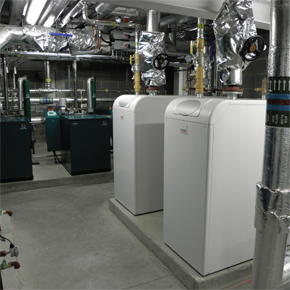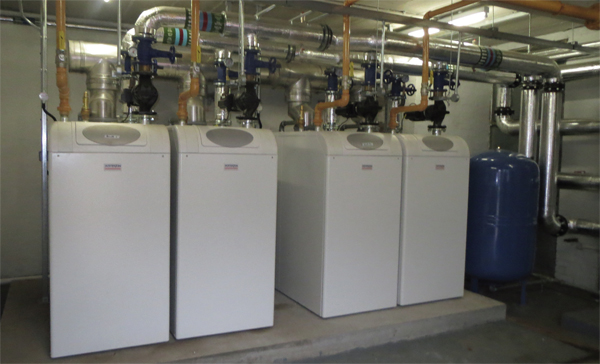
Hospitals & healthcare: thinking long-term energy efficiency
Trying to plan for what things might look like in five, ten, or 15 years from now is tough for any organisation, but never more so than in hospitals and healthcare facilities where both time and budget constraints are an ongoing issue.
This is where making smart choices at the design stage of a system can be vital to ensure both cost efficiencies and reduced service disruption, as Neville Small, sales director at Potterton Commercial, explains in the June issue of PSB Magazine…
The UK’s healthcare sector spends over £400m per year on energy, with heating alone accounting for as much as 60% of a typical building’s total energy bill.
As a result, an effective system design has a huge role to play in improving efficiency, particularly given the higher heating loads and continuous demand year round. At the same time, these long running hours mean that such applications offer greater potential to achieve optimum operational efficiencies.
In last year’s Autumn Statement, the Government announced that the NHS in England will be expected to make £22bn in efficiency savings. While these efficiencies will need to be made across the board, making improvements to a hospital’s heating system can result in significant operational cost savings and reduced carbon emissions too.
The good news is that to help achieve this ambitious target, the Treasury also said it will provide £295m over the next five years to support energy efficiency upgrades in hospitals, schools and other public sector buildings.
However, even with the pledged funding, the lag between actually seeing the cash in the pot, partnered with a reluctance to carry out major refurbishment projects due to potential downtime, can leave many facilities losing out on the benefits of a more efficient system.
While totting up the immediate outlay is likely to be a priority, when assessing the cost of new plant equipment it is important to go one step further by scrutinising how appliances will perform over time. In turn, this can provide an additional tick in the box for those decision makers and budget holders at the top of the chain.
Here, implementing a whole-life costing approach is key, producing a spend profile of the product over its expected life. By looking at the long-term operational cost of each individual asset within the build, rather than the initial purchasing and installation cost, building designers can be safe in the knowledge that they are recommending a solution that is cost-effective in the truest sense.
When it comes to the heating system and commercial boilers specifically, whole-life costing should include anticipated energy, installation, maintenance and servicing costs.
Often, components which are cheaper at the initial stages can easily end up costing more in the long run, whether as a result of operational costs or because they need repairing or replacing more often. Careful selection of high quality, long-lasting and efficient heating equipment will help bring these costs down.
At the same time, it is essential to make robust calculations before plant is specified, taking into account both the maintenance costs and the energy efficiency of the product in question.
Both the specifier and the enduser should be clear on the what, when and how: What work will need doing to that particular component throughout its life? When throughout its lifetime should the work be done? And finally, how much it will cost to do the work, taking into account access and downtime?
The answers to these questions don’t have to be complex. Straightforward payback calculations are useful to demonstrate the benefits of investing in higher quality products from the beginning to reduce energy consumption in the long run. Maintenance costings should take into account both predictive and reactive work, as well as disposal costs and any downtime.
These calculations alone will give a good indication of how a component will perform, and an idea of the expense it will incur to the building owner as a result. For a more accurate forecast, other factors such as depreciation, assumptions on energy costs and even inflation can be included, depending on the application and level of detail required.
The proof and value of making whole lifetime calculations is in the building’s operational costs. An appliance made of lasting, quality components and materials which may cost more to purchase initially, may cost much less to run throughout its lifecycle, with a shorter payback period, resulting in better savings. In this way, the specifier or heating engineer can be sure that the end-user will be left with the best system to suit their functional and financial requirements.
For example, many commercial boiler solutions are available on the market today to suit different applications, and the lifecycle costs of these can vary greatly depending on the type of equipment used. So, researching the credentials of the various solutions and suppliers as well as carefully considering usage and demand will lead to an all-round better solution.
Given that heating is vital to any public building, a system that operates effectively, reliably, and efficiently is key. And nowhere is this more of a priority than in healthcare sector, where patient comfort and care is imperative.
Ultimately, by thinking long-term from the word go, building designers will be armed with the evidence to back up their recommendations, helping healthcare estate managers to make the appropriate investment for the future while also providing a long-term, effective heating system.
Latest news

15th April 2025
West Fraser: CaberDek earns top marks from Home Counties carpentry specialist
A specialist carpentry sub-contractor covering housing sites across a large swathe of the Home Counties has come to value CaberDek from the West Fraser range for a variety of reasons: not least because the high quality panel product doesn’t destroy his operatives’ electric saws!
Posted in Articles, Building Industry News, Building Products & Structures, Building Systems, Case Studies, Restoration & Refurbishment, Retrofit & Renovation, Roofs, Timber Buildings and Timber Products, Wooden products
15th April 2025
GEZE: The Role of Access Control Systems in Enhancing Building Safety
Jane Elvins, Specification and Business Development Manager at GEZE UK, delves into the role of access control systems in enhancing building safety…
Posted in Access Control & Door Entry Systems, Architectural Ironmongery, Articles, Building Industry News, Building Products & Structures, Building Services, Doors, Facility Management & Building Services, Health & Safety, Restoration & Refurbishment, Retrofit & Renovation, Security and Fire Protection
11th April 2025
Don’t Do a Dave! It’s Time to Lock FIT Show 2025 in Your Calendar!
It’s that time again – FIT Show is back! You could be forgiven for thinking there won’t be much new to see when FIT Show returns to the NEC from 29 April – 1 May. Wrong!
Posted in Articles, Building Industry Events, Building Industry News, Building Products & Structures, Building Services, Continuing Professional Development (CPD's), Exhibitions and Conferences, Information Technology, Innovations & New Products, Restoration & Refurbishment, Retrofit & Renovation, Seminars, Training
11th April 2025
Insight Data: Boost construction success with project and prospect data
For those working in construction – in whatever capacity – the last few years haven’t been much fun. And according to the latest statistics, it would seem the challenges are continuing – Alex Tremlett, Insight Data’s Commercial Director, has more…
Posted in Articles, Building Industry News, Building Services, Information Technology, news, Research & Materials Testing
 Sign up:
Sign up: 